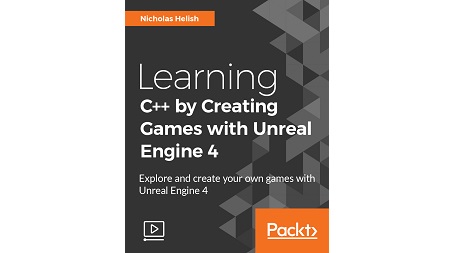
English | MP4 | AVC 1920×1080 | AAC 44KHz 2ch | 3h 39m | 1.21 GB
Program in C++ and work your way around in the world of Unreal Engine
Unreal Engine 4 is a complete suite of game development tools made by game developers, for game developers. From mobile games to high-fidelity VR experiences to console blockbusters, Unreal Engine 4 gives you everything you need to start, ship, grow and stand out from the crowd.
This video course shows you how to successfully set up Visual Studio for Windows so that you can begin developing games using the game engine: Unreal Engine 4. You’ll also learn how C++ works and really get to grips with it. You’ll learn how to start a C++ based Unreal Engine 4 project and use the editor. You will then learn how to debug Unreal Engine 4 games right within the Visual Studio IDE, before moving on to building gameplay elements that affect the player. You will use this knowledge to create a first-person shooter for the player and interactables within the environment to create gameplay elements within the world.
This video tutorial offers a project-based approach to teach you the skills required to develop games within Unreal Engine 4 using C++.
What You Will Learn
- Gain enough knowledge and understanding of C++ to use it in the Visual Studio IDE
- Use breakpoints within Visual Studio and Unreal Engine 4
- Understand Unreal Engine 4’s codebase
- Create gameplay elements within Unreal Engine 4 using C++
- Integrate visual aspects with code aspects within Unreal Engine 4
- Create enemy types that the player can fight
- Create an interaction system that allows the player to affect the world
- Package your project for shipping
Table of Contents
01 – The Course Overview
02 – Installing Visual Studio 2015 and Unreal Engine 4 and Exploring the Visual Studio IDE
03 – Variables and Methods_Functions
04 – Pointers and Memory Management
05 – Understanding the Unreal Engine’s Codebase and Naming Conventions
06 – Explaining the Unreal Engine’s Codebase and the Importance of Planning Scope
07 – Explaining Unreal Engine’s Garbage Collection and Its API
08 – Creating Our Project in Unreal Engine 4 and Initial Setup
09 – Exploring the Unreal Engine Interface and Importing Our Assets
10 – Creating the Player Character’s Code Part One – Basic Character Setup
11 – Creating the Player Character’s Code Part Two – Setup Our Player Character
12 – Creating the Player Character’s Code Part Three – Basic Movement
13 – Creating the Player Character’s Code Part Four – Sprinting
14 – Creating the Player Character’s Code Part Five – Shooting
15 – Creating the Player’s HUD Part One – Basic Setup with UMG Widgets
16 – Creating the Player’s HUD Part Two – Building the Widget Blueprint
17 – Creating the Player’s HUD Part Three – Connecting the Player Character with the HUD
18 – Setting Up Our Game Mode
19 – Creating Our Respawning System
20 – Setting Up Our Pickup System
21 – Creating Our Pickups
22 – Creating Our Destructible Items
23 – Setting Up Our Main Menu Widget and Level
24 – Adding Functionality to Our Main Menu Widget and Level
25 – Setting Up Our Level Ending Actor
26 – Setting Up Our Pause Menu Widget
27 – Adding Functionality to Our Pause Menu
28 – Creating Our Interaction System by Using Unreal Interfaces
29 – Creating Our Initial Interactable Base Class
30 – Setting Up Our Sub-Interactable Objects
31 – Adding Functionality to Our Sub-Interactable Objects
32 – Allowing the Player to Use Our Interaction System
33 – Building Our Level and Packaging Our Project for Shipping
Resolve the captcha to access the links!